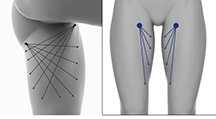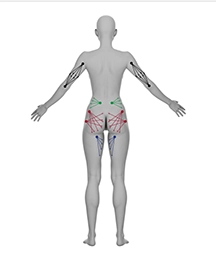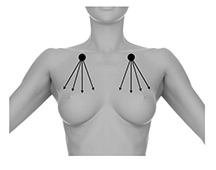Introduction: radiofrequency skin tightening
Radiofrequency skin tightening is a popular non-surgical treatment that uses radiofrequency energy to heat the deeper layers of skin and stimulate collagen production, resulting in firmer, tighter, and more youthful-looking skin. This safe and effective treatment can improve signs of aging and skin laxity on areas like the face, neck, arms, abdomen, and thighs.
How Does Radiofrequency Skin Tightening Work?
Radiofrequency skin tightening utilizes electromagnetic energy to heat the dermis and subcutaneous fat while sparing the epidermis or surface of the skin [1]. The radiofrequency waves penetrate deep into the skin’s deeper layers, causing collagen fibers to contract and stimulating new collagen production over time [2]. This results in firmer, denser collagen that lifts and tightens loose, sagging skin.
The Benefits of Radiofrequency Skin Tightening
Some benefits of radiofrequency skin tightening include:
Non-Invasive With Little Downtime

Radiofrequency skin tightening is a non-surgical procedure that does not require incisions or anesthesia. There is no downtime required, and patients can resume normal activities immediately after treatment [3]. This makes it an appealing alternative to surgical facelifts.
Improves Skin Laxity
By stimulating collagen production and contraction, radiofrequency skin tightening can significantly improve mild to moderate loose, sagging skin on areas like the face, jowls, neck, arms, stomach, and thighs [4]. Skin will look firmer, smoother, and more toned.
Long Lasting Results
Results from radiofrequency skin tightening can last over a year, although maintenance treatments are recommended every 6 months to a year to maintain results [5]. The production of new collagen continues over the course of 3-6 months post-treatment.

Safe With Minimal Side Effects
Radiofrequency treatment is safe for all skin types. Side effects are typically mild and temporary, including redness and swelling that resolve within a few hours [6]. Radiofrequency does not damage the skin surface.
Improves Texture & Tone
In addition to tightening skin, radiofrequency also improves the overall tone and texture of skin, reducing fine lines and wrinkles and increasing smoothness [7]. The production of new collagen helps to plump skin for a more youthful appearance.
Who Is a Good Candidate for Radiofrequency Skin Tightening?

Ideal candidates for radiofrequency skin tightening include those with [8]:
- Mild to moderately loose, sagging skin on the face, neck, jowls, abdomen, arms, thighs, or knees
- Mild to moderate wrinkles and fine lines
- Loss of skin tone and elasticity due to aging
- Normal, non-oily skin
- The ability to withstand mild heat applied to the skin surface
Radiofrequency skin tightening works best for individuals in their 30s up to 60s who are beginning to notice signs of skin laxity and aging but do not require a surgical facelift. It can help delay a facelift. This treatment is not recommended for people with very loose, inelastic skin, oily/acne-prone skin, or those prone to keloid scarring.
How Many Radiofrequency Skin Tightening Treatments Are Needed?
Most patients require 4-6 radiofrequency skin tightening sessions spaced 2-4 weeks apart for optimal results [9]. Maintenance sessions every 6-12 months are recommended. Each session takes about 45 minutes for a full face and neck treatment. The number of treatments depends on skin laxity and the desired degree of tightening.
What Does the Treatment Feel Like?
Radiofrequency skin tightening is comfortable but patients may feel a warm sensation as the radiofrequency delivers heat into the skin [10]. Your provider can adjust the intensity. There is no pain or anesthesia required. Some temporary redness and swelling may occur after treatment.
How Long Do Results Last?
Most patients see noticeable improvements in skin firmness after the first couple of sessions. However, collagen remodeling and production of new collagen fibers continues for 3-6 months after the final treatment [11]. Most results last about 1-2 years before a maintenance session is needed. Results vary based on age and skin condition.
Does Radiofrequency Skin Tightening Really Work?
Multiple studies have found radiofrequency skin tightening to effectively improve skin laxity. In two clinical trials, over 70% of patients rated their treatment results as good or excellent after receiving radiofrequency skin tightening on the face and body [12] [13]. Objective ultrasound measurements also showed significant improvements in skin tightening. Radiofrequency has been safely and effectively used for skin tightening for over a decade.
Are There Any Side Effects?
Radiofrequency skin tightening is very safe. Side effects are usually minimal, temporary, and include [14]:
- Mild tenderness, swelling, or redness that resolves within a few hours
- Temporary sensation of heat or pain during the procedure
- Petechiae (minor bruising), but very rare
- Excessive swelling or blistering in rare cases
No significant downtime is required. Make sure to follow your provider’s aftercare instructions, including icing the area and using moisturizer/sunscreen.
How Much Does Radiofrequency Skin Tightening Cost?
The average cost of radiofrequency skin tightening ranges from $1,500 – $4,000 per treatment area over the course of multiple sessions [15]. Smaller areas like the jawline or neck cost on the lower end, while a full face and neck treatment costs upwards of $4,000. The technology, location, experience of your provider, and number of treatments can all impact cost. Many clinics offer bundled discounts for multiple treatment packages.
Internal Radiofrequency Devices
Renuvion technology
Renuvion J plasma utilizes a combined energy of radiofrequency energy combined with helium J plasma. Renuvion has the main benefit of providing speedy treatment time which makes it practical for treatment of skin redundancy in the operating room. The disadvantage of Renuvion is that it requires the infiltration of tumescent solution and pre-emptive liposuction prior to treatment. This requirement follows the need to create an open space to allow for the delivery of a larger cannula and to accommodate the heat created.
Attiva Technology
ATTIVA® Subdermal Induced Heat (S.I.H.) Technology is the result of 5 years of advanced scientific research. Three international patents protect ATTIVA subdermal-induced heat technology. This technology may be employed by medical professionals such as physicians, naturopathic doctors, nurse practitioners, physician assistants, and registered nurses. This range of medical providers who may treat the signs of aging, prolonged gravity, and sun damage without invasive surgery translates to efficient, safe, and affordable treatments. ATTIVA® S.I.H. Technology offers patients dramatic aesthetic enhancements to the quality of their skin and soft tissues with minimal downtime, no scarring, and immediate results. A new benchmark in the medical treatment of aging, sun damage, and loose skin without the need for general anesthesia and prolonged recovery is now available. ATTIVA subdermal induced heat S.I.H. technology provides several real advantages not offered by any other medical device alternatives that include:
- Minimally invasive treatment that can be completed in the office while you remain awake
- Avoidance of incisions that can result in subsequent scars
- Precludes the need for infiltration of fluids and/or gasses prior to treatment
- Immediate improvements following a “lunchtime” procedure
- A quick recovery period means no income loss or setbacks in your social calendar
- Reducing mechanical trauma resulting in unnecessary soft tissue injury or swelling
- Minimizing the risk of skin compromise with external skin monitoring and temperature safety gauges
- Less inconvenience associated with frequent postoperative visits to the clinic
Conclusion: Radiofrequency skin tightening
Radiofrequency skin tightening offers a safe, non-invasive way to improve mild to moderate signs of aging by stimulating new collagen production in the deeper layers of the skin. Multiple sessions are needed for optimal tightening and contouring of the face and body. While results vary, the majority of patients see significant, long-lasting improvements in skin laxity after completing a course of radiofrequency skin tightening treatments. Consult an experienced cosmetic provider to determine if you are a good candidate.
References
[1] https://pubmed.ncbi.nlm.nih.gov/21776467/
[2] https://pubmed.ncbi.nlm.nih.gov/25588751/
[3] https://pubmed.ncbi.nlm.nih.gov/?term=renuvion
[4] https://pubmed.ncbi.nlm.nih.gov/29789515/
[5] https://www.ncbi.nlm.nih.gov/pmc/articles/PMC3315877/
[6] https://www.ncbi.nlm.nih.gov/pubmed/25609948
[7] https://onlinelibrary.wiley.com/doi/abs/10.1111/cup.12002
[8] https://www.ncbi.nlm.nih.gov/pmc/articles/PMC3798808/
[9] https://pubmed.ncbi.nlm.nih.gov/35081544/#:~:text=Abstract,not%20wish%20to%20have%20surgery.
[10] https://pubmed.ncbi.nlm.nih.gov/29351373/
[11] https://pubmed.ncbi.nlm.nih.gov/24049928/

